Lakes are either freshwater or saltwater aquatic settings that typically hold a significant amount of water. The United States is home to a lot of lakes, including a few of the largest lakes in the world! Yet, we can also take a look at the available information to determine which of the lakes in the U.S. are the biggest. We’ve come up with a list of the 20 largest lakes in the U.S., and we’ll show you how they rank by area, length, and depth!
What is a Lake?
It’s important to know what lakes are before we define the 20 largest lakes in the U.S. Many people wonder about the difference between a lake and a pond because they are so similar. However, a lake has the following qualities:
- Depth: Lakes are deeper than ponds, reaching at least 20 feet in depth in most cases.
- Shape: Lakes have a more oval-like shape than ponds
- Water Type: Lakes are mostly freshwater, but they can also be brackish or saline. Ponds are solely freshwater.
- Open outlet: Lakes have an opening to other bodies of water from which they derive their water.
- Size: Lakes are typically larger than 0.3 square miles.
These concepts should help you understand what a lake is and how it is different from other forms of water like ponds, oceans, and rivers.
Animals Found Near Lakes
Lakes are a vital source of water and nutrients for a wide range of animal species.
Here are some of the animals that are commonly found near lakes:
- Birds: Ducks, geese, and other waterfowl are a common sight near lakes.
- Fish: Lakes are home to a wide range of fish species, including trout, bass, and catfish.
- Mammals: Many mammal species are found near lakes, including beavers, muskrats, and otters.
- Reptiles: Turtles and snakes are often found near lakes, as they use the water as a source of food and as a place to bask in the sun.
- Insects: A variety of insects are found near lakes, including dragonflies, mayflies, and mosquitoes.
Lakes are a rich and diverse ecosystem that is home to a wide range of animal species.
The 20 Largest Lakes in the United States
The United States is home to a vast number of lakes. Many of the lakes in the U.S. are among the largest that exist. Looking at the 20 largest lakes in the U.S., it’s clear that the biggest ones are significantly larger than the others even within this list. Our list will give you an idea of how massive some of these bodies of water are relative to lakes near you.
20. Rainy Lake
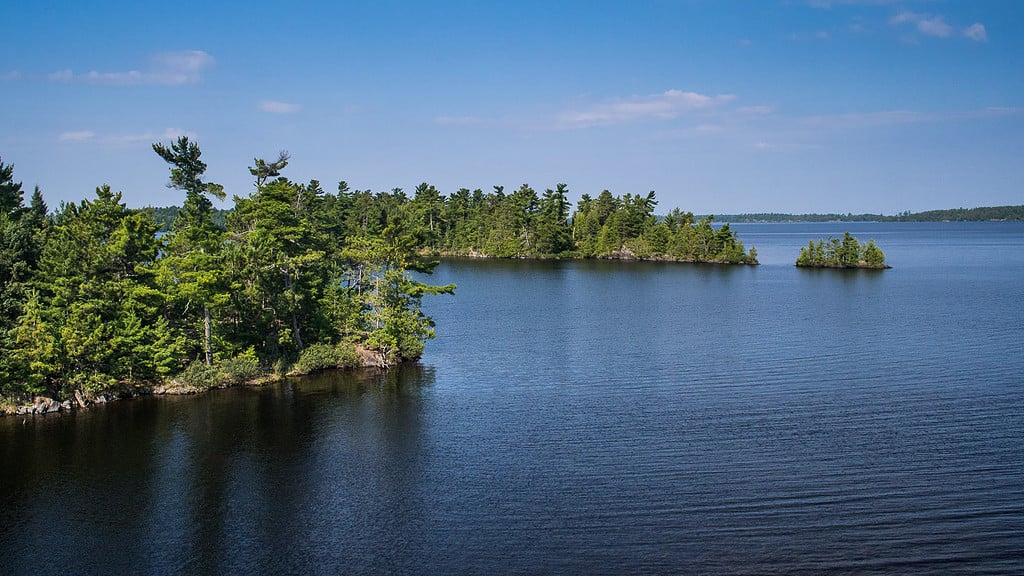
Rainy Lake is located in Minnesota and Canada.
©Jeffkantor / CC BY-SA 3.0 – License
| Area | Length | Depth |
| 360 sq mi | 50 mi | 106 ft |
Rainy Lake is a natural lake that is on the border of Minnesota and Canada, so it’s not located entirely within the U.S. This part of the U.S. gets very cold in the winter, and this lake is the site of many winter sports. People come from all over the area to go fishing, skiing, and snowmobiling around the lake which requires an ice road for access.
19. The Salton Sea

The Salton Sea is just as salty as it sounds
©bonandbon/Shutterstock.com
| Area | Length | Depth |
| 343 sq mi | 34.8 mi | 43 ft |
As the name suggests, Salton Lake is a saltwater lake, and it’s man-made. This lake is entirely within the state of California, and projects began in 1900 to turn this area into a river. Interestingly, this lake is referred to as a sea, and it has a higher salinity than the nearby Pacific Ocean.
18. Fort Peck Lake

Fort Peck Lake was first filled in 1947 as part of a dam system on the Missouri River
©iStock.com/bobloblaw
| Area | Length | Depth |
| 393 sq mi | 134 mi | 76 ft |
Fort Peck Lake is located in Montana, and it was designed as a reservoir and dam system that would help with the navigation of the Missouri River. This river was constructed from 1933 until 1940, and the reservoir first reached its capacity in 1947. This area is a tourist attraction that is popular for hiking and other sports.
17. Selawik Lake
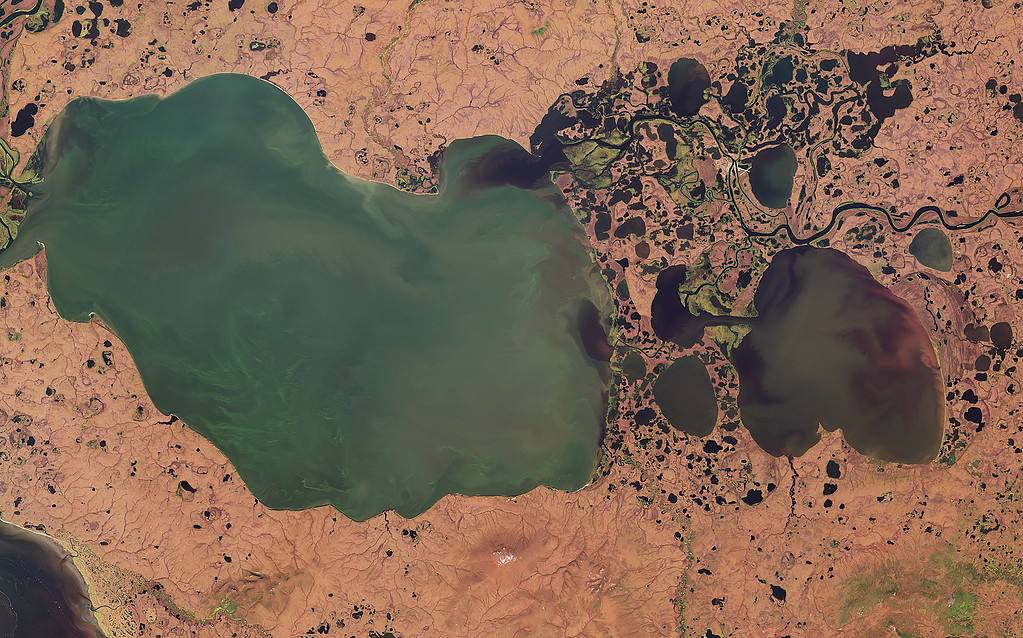
Selawik Lake is near the Pacific Ocean in the state of Alaska.
©Contains modified Copernicus Sentinel data 2018, CC BY-SA 3.0 IGO, via Wikimedia Commons – License
| Area | Length | Depth |
| 404 sq mi | 31 miles | No Info |
Located in Alaska, Selawik Lake is the third-largest lake in the massive state. It is located in the northwestern section of Alaska, almost on the Pacific Ocean. This lake is near the Selawik National Wildlife Refuge.
16. Red Lake
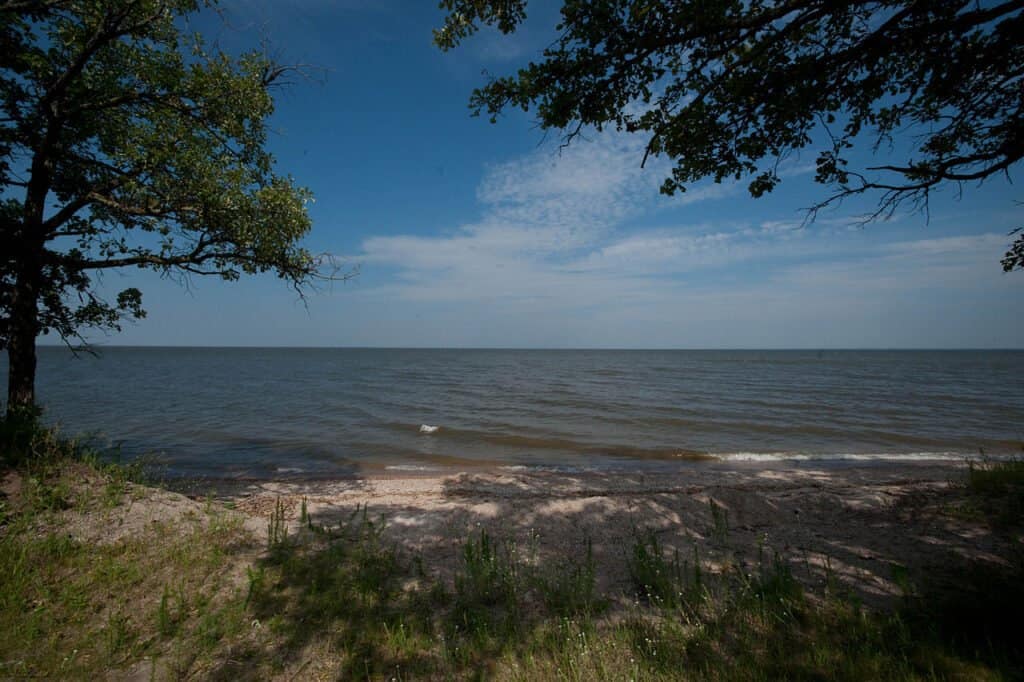
Red Lake is separated into two parts by a peninsula
©Andrew Filer / Creative Commons – License
| Area | Length | Depth |
| 430 sq mi | 20 mi | 270 ft |
This lake is located in the north part of Minnesota, and it is located entirely within the Red Lake Indian Reservation. Interestingly, the lake is actually separated into two sections by a peninsula, but it does not completely cut across the middle, so this is still a single lake. Red Lake is known for its wide variety of fish living in it.
15. Lake St. Clair

Lake St. Clair shares a shoreline with the U.S. and Canada
©iStock.com/Brian Sevald
| Area | Length | Depth |
| 440 sq mi | 26 mi | 27 ft |
Lake St. Clair is connected to other large bodies of water like the Detroit River and Lake Erie as well as the St. Clair River. The lake spans both Michigan and Ontario, so it’s located both in the U.S. and Canada.
14. Becharof Lake

Becharof Lake is a very deep lake in the southern peninsula of Alaska.
©R.J. Wilk, U.S. Fish and Wildlife Service (US-FWS) / Public domain, from Wikimedia Commons, the free media repository – License
| Area | Length | Depth |
| 453 sq mi | 37 mi | 600 ft |
Located on the peninsula of Alaska, Becharof Lake was discovered in the 18th century. It became part of the United States in 1867. Although it is the 14th largest lake in the United States by area, it’s the 8th largest lake by volume in the U.S. due to its great depth.
13. Lake Sakakawea
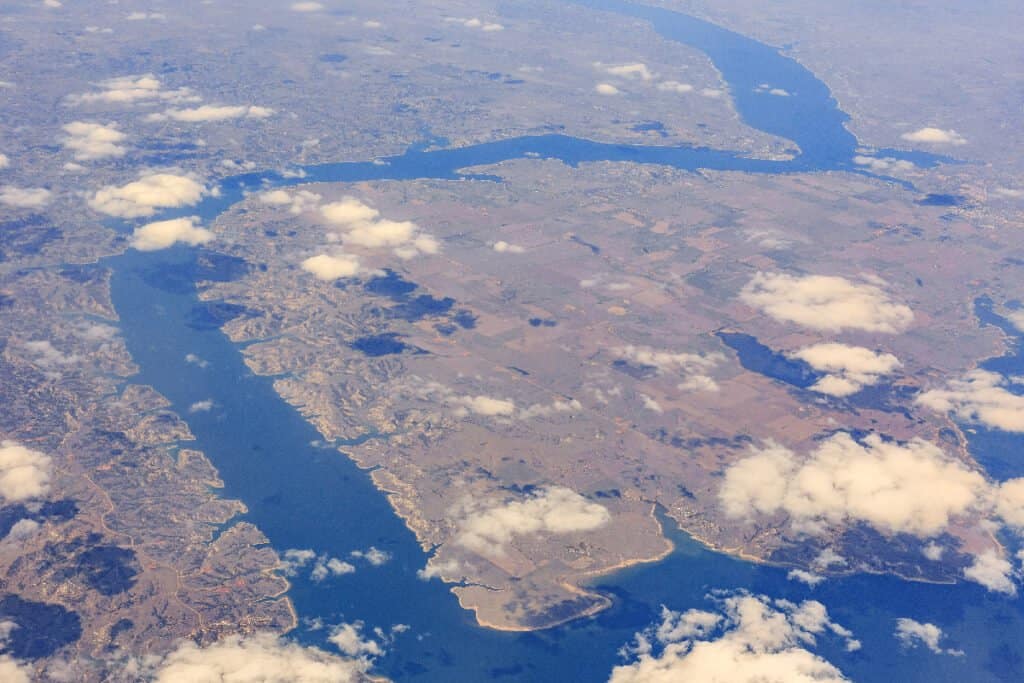
Lake Sakakawea is a reservoir, a man-made lake created in 1953
©Kit Leong/Shutterstock.com
| Area | Length | Depth |
| 480 sq mi | 178 mi | 180 ft |
This lake is a man-made construction located entirely in North Dakota. This reservoir was made in 1953, and it is the second-largest man-made lake in the U.S. Today, the lake is a popular area for people to camp, boat, hike, and fish. It’s managed by various agencies, including the Fort Berthold Indian Reservation.
12. Lake Champlain
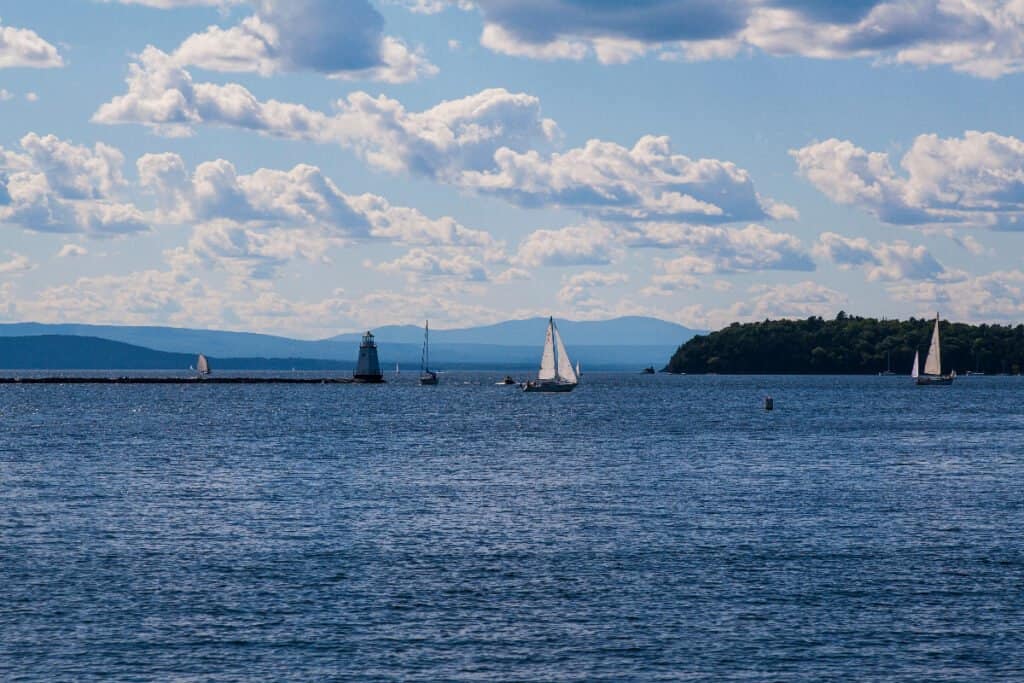
Lake Champlain is a lake that is rife with history
©Mark Castiglia/Shutterstock.com
| Area | Length | Depth |
| 514 sq mi | 107 mi | 400 ft |
Lake Champlain is a natural lake that extends into New York and Vermont in the U.S. and Quebec in Canada. This lake has been the site of historic moments such as the Battle of Valcour Island and the War of 1812. The water serves as an area of transit for goods and people via rail crossings as well as a ferry.
11. Lake Pontchartrain
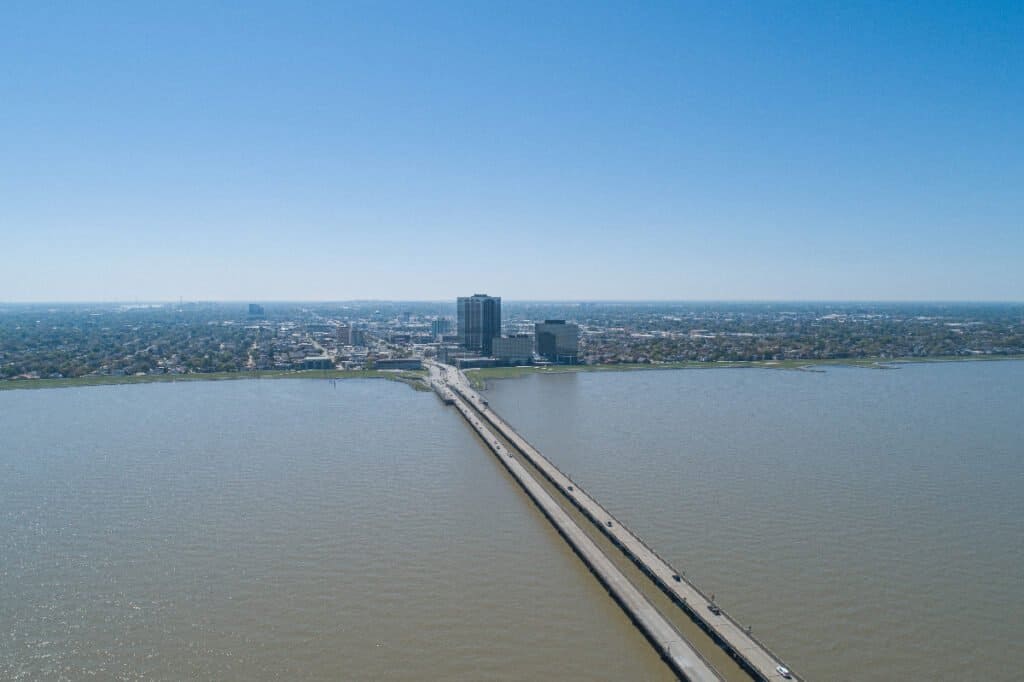
This lake is mostly known for the levee breaches in 2005
©Mark Runde/Shutterstock.com
| Area | Length | Depth |
| 631 sq mi | 40 mi | 65 ft |
Louisiana’s Lake Pontchartrain is a natural and brackish lake due to its proximity to the Gulf of Mexico. The lake became famous during Hurricane Katrina when several of its levees were breached due to the immense power of the storm. The effects of the breach are still being felt today, and the lake suffered severe pollution.
10. Lake Okeechobee
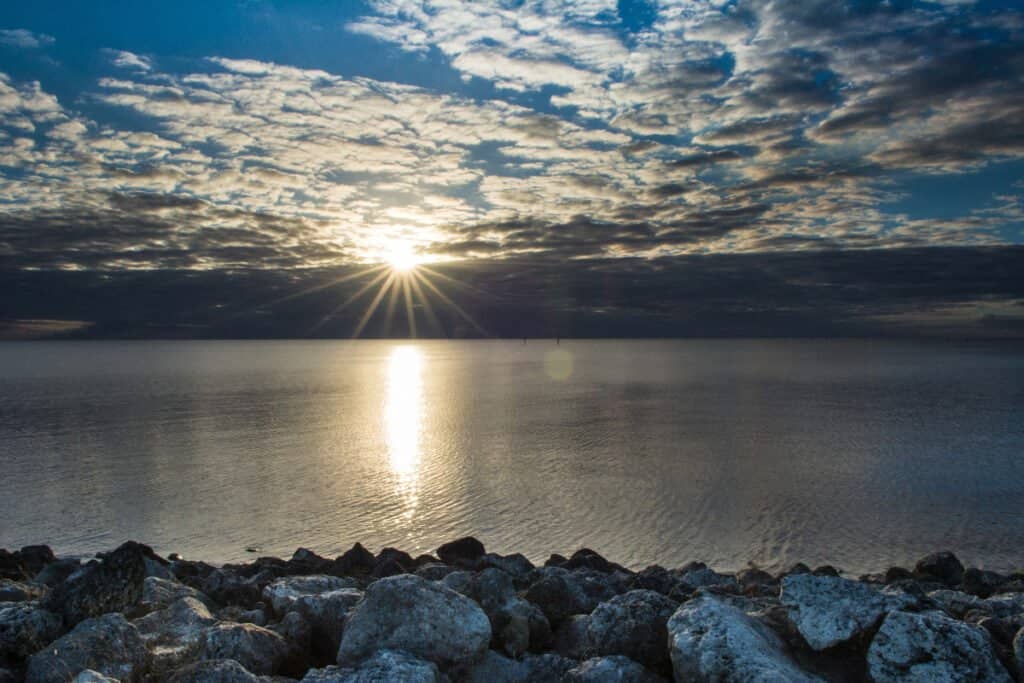
Florida’s inland sea is another name for this large, shallow lake
©Allison Michael/Shutterstock.com
| Area | Length | Depth |
| 662 sq mi | 36 mi | 12 ft |
This lake is called Florida’s inland sea because of its significant size which reaches upwards of 700 square miles when abundant water is present in the atmosphere. Although this lake is very large, it’s not very deep, averaging about 12 feet in depth throughout. Unfortunately, this lake has suffered greatly from the presence of toxins from hazardous runoff.
9. Lake Oahe
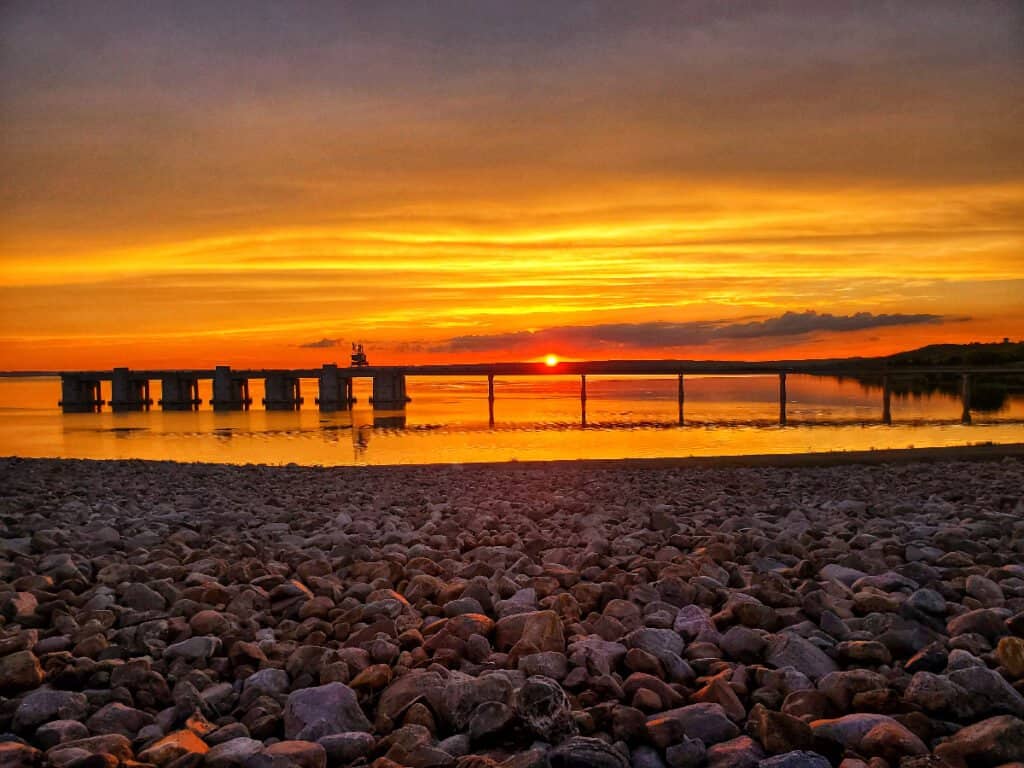
Lake Oahe is another man-made lake, and it extends from North Dakota into South Dakota
©C.drefs/Shutterstock.com
| Area | Length | Depth |
| 685 sq mi | 231 mi | 205 ft |
Lake Oahe is a reservoir on the Missouri River, and it’s long enough that it spans between North Dakota and South Dakota. The lake is a significant recreational area with many fishers coming to the area. The lake is currently in the middle of various legal suits because of the Dakota Access Pipeline which is supposed to have a section run under the lake.
8. Iliamna Lake
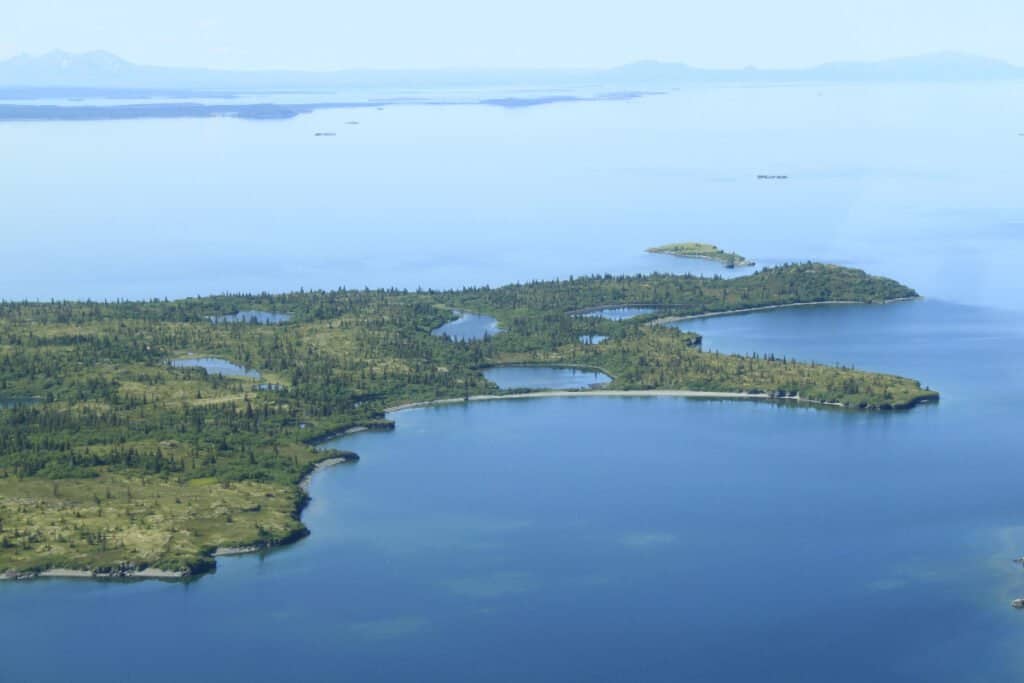
This lake is the third-largest located entirely within the United States
©Nessie91/Shutterstock.com
| Area | Length | Depth |
| 1,014 sq mi | 77 mi | 144 ft |
The Iliamna Lake is located in Alaska, and it’s the third-largest lake contained entirely within the United States. The lake is known in local legends for being the home of a supposed monster, and it’s also a popular fishing spot. The lake is natural and it’s in the southern area of Alaska, almost near the peninsula.
7. Lake of the Woods

The Lake of the Woods is mostly located in Canada; a smaller section is also located in Minnesota
©iStock.com/Wildnerdpix
| Area | Length | Depth |
| 1, 679 sq mi | 68 mi | 210 ft |
The Lake of the Woods splits the land between Minnesota and parts of Canada, and the vast majority of it is in Canada. This area is home to the Royal Lake of the Woods Yacht Club as well as a lot of recreation seekers. The lake is home to several dams and provides drinking water to Winnipeg.
6. Great Salt Lake

This salty lake has been shrinking in recent years due to massive droughts
©Bella Bender/Shutterstock.com
| Area | Length | Depth |
| 2,117 sq mi | 75 mi | 33 ft |
The Great Salt Lake is located entirely in the state of Utah, and it’s known for its high level of salinity. In fact, this water is much saltier than ocean water. Currently, the lake has shrunk significantly owing to droughts in its tributaries. The lake has a unique ecosystem with many animals living in the area.
5. Lake Ontario
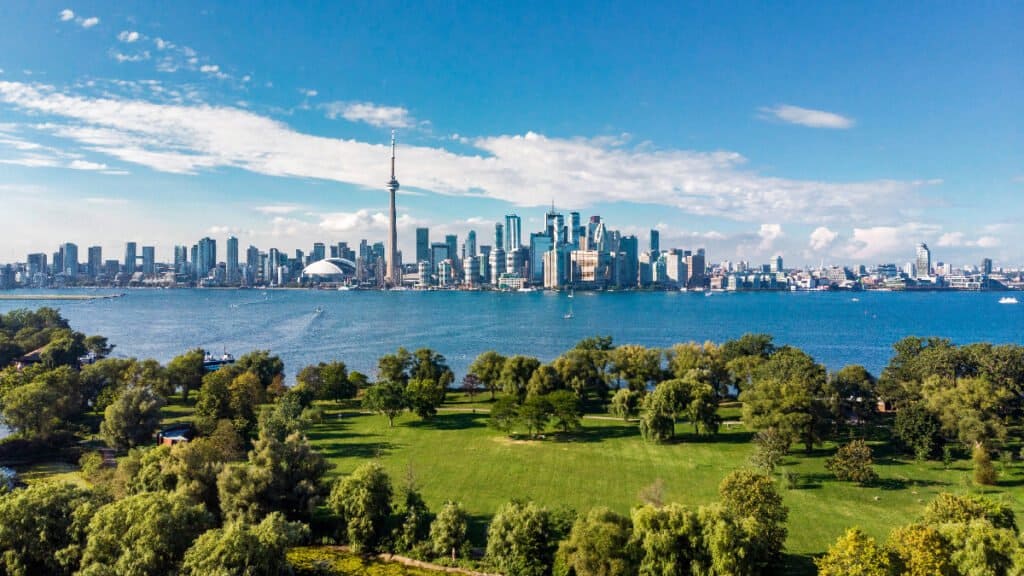
Lake Ontario derives its name from the Huron word for “Great Lake”
©iStock.com/R.M. Nunes
| Area | Length | Depth |
| 7,340 sq mi | 193 mi | 801 ft |
Spanning the space between New York and Ontario, Lake Ontario is one of the Great Lakes. It’s the only one of the Great Lakes to not have a shoreline from Michigan. A fun fact about Lake Ontario is that the word comes from the Huron and means “Great Lake”. So, this Great Lake is itself named “Great Lake.”
4. Lake Erie
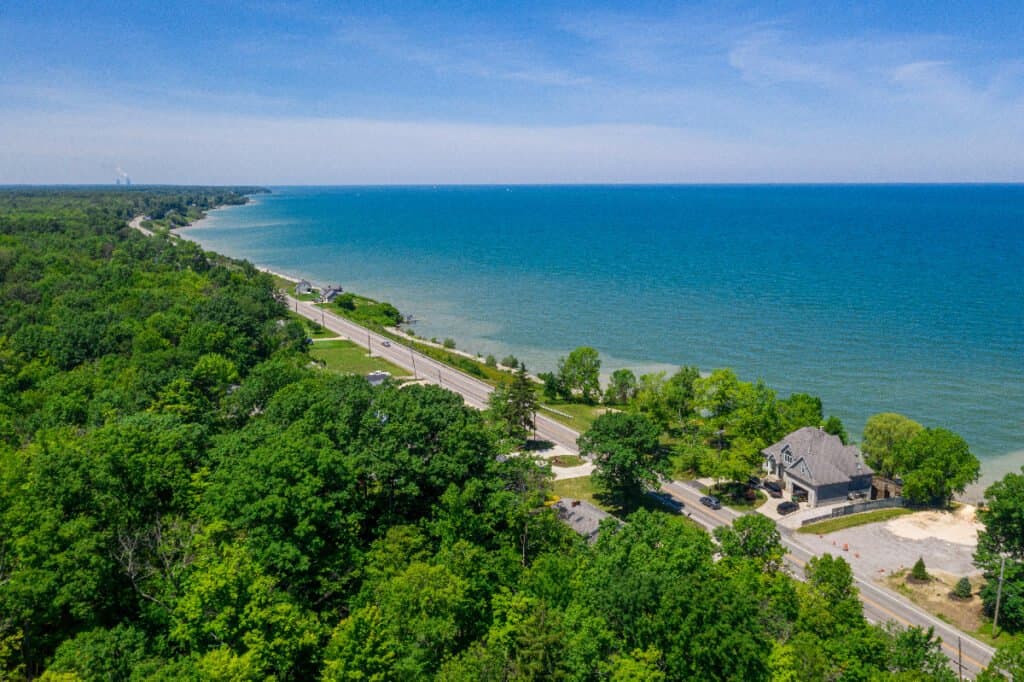
Lake Erie is known for its wild weather
©IanSkylake17/Shutterstock.com
| Area | Length | Depth |
| 9,910 sq mi | 241 mi | 210 ft |
The fourth-largest lake in the United States is another one of the Great Lakes. Lake Erie has shorelines in various parts of Canada, Pennsylvania, New York, Ohio, and Michigan. The lake is known for being in a location with frequent thunderstorms that make traversing the lake somewhat dangerous. The lake is known for its numerous lighthouses, too.
3. Lake Michigan
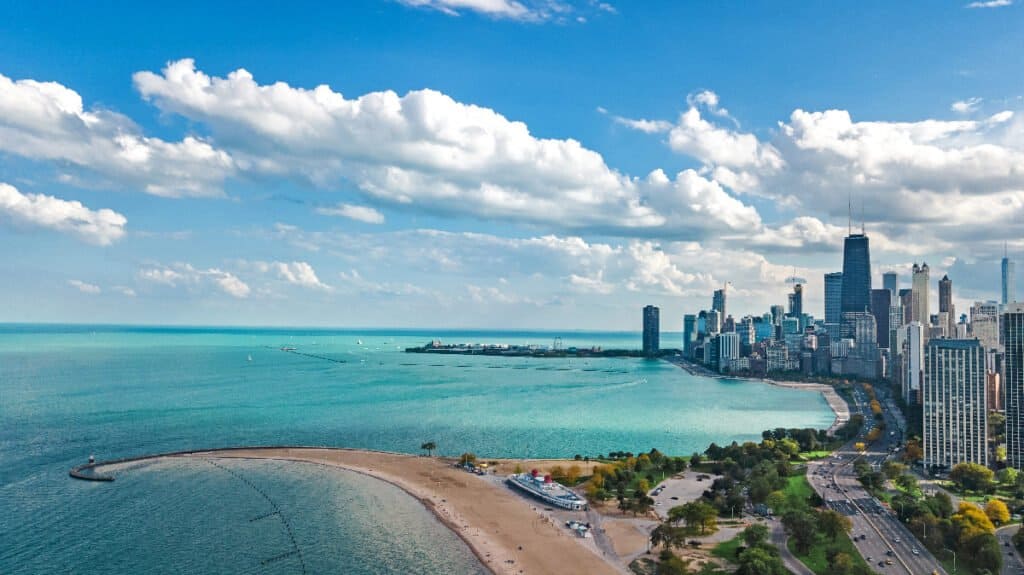
Lake Michigan has 12 million people living along its banks in various cities
©JaySi/Shutterstock.com
| Area | Length | Depth |
| 22,300 sq mi | 307 mi | 922 ft |
Lake Michigan is the second-largest of the Great Lakes by volume, but the third-largest lake in the United States by area. This lake has shorelines with Wisconsin, Illinois, Indiana, and Michigan. It has 12 million people living in cities along its banks.
2. Lake Huron
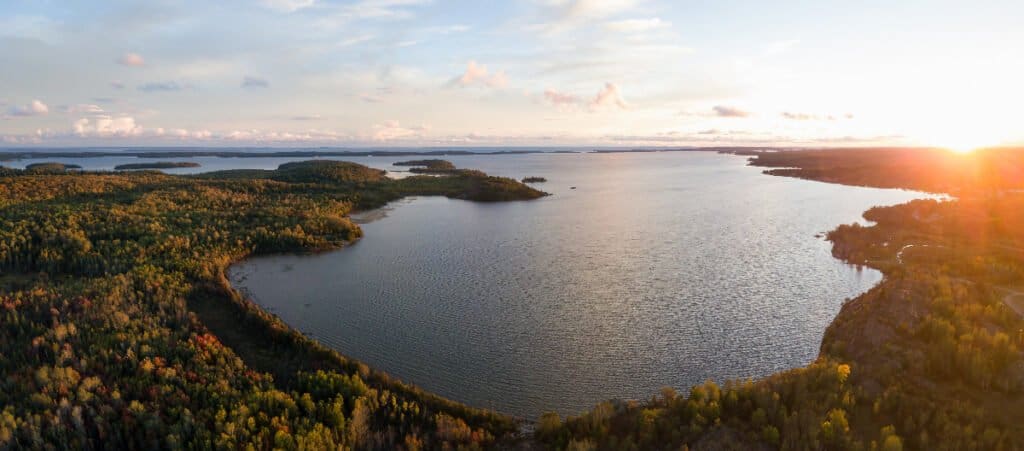
Lake Huron is a large lake that is connected to Lake Michigan
©EB Adventure Photography/Shutterstock.com
| Area | Length | Depth |
| 23,000 sq mi | 206 mi | 276 ft |
Another Great Lake, Lake Huron only shares a shoreline in Michigan and Ontario, Canada. The lake is sometimes referred to as one entity with Lake Michigan, called Lake Michigan-Huron. However, many people have not adopted this definition even though the two lakes share water flow.
1. Lake Superior
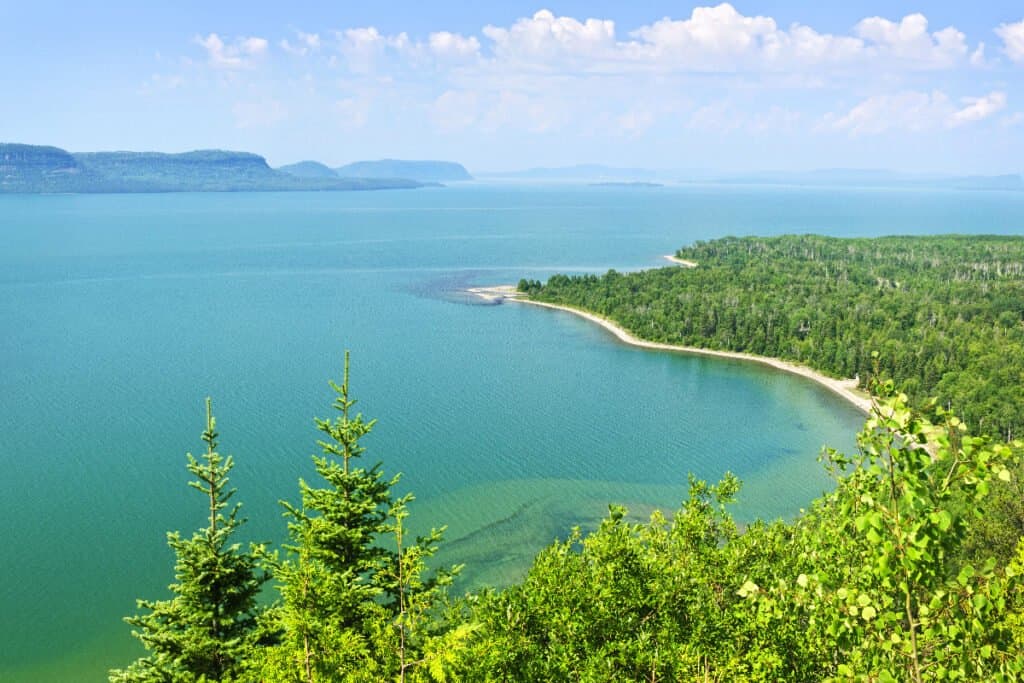
Lake Superior holds 10% of the world’s surface freshwater
©Elena Elisseeva/Shutterstock.com
| Area | Length | Depth |
| 31, 700 sq mi | 381 mi | 1,333 ft |
Lake Superior is the largest lake in the United States. This lake shares shorelines with Michigan, Minnesota, and parts of Ontario. This lake is known for holding 1/10th of the Earth’s surface freshwater; it’s massive. The lake’s maximum depth is over 1,000 feet!
What is the Largest Lake in the World?
The largest lake in the world is the Caspian Sea. Even though this lake is brackish and has been called a sea, it meets the definition of a lake.
What is the Largest Lake Contained Entirely in the United States?
The largest lake contained entirely in the United States is Lake Michigan because it does not share a shoreline with any other country.
What is the Deepest Lake in the United States?
Lake Superior is the deepest lake in the United States, averaging several hundred feet in depth but also reaching 1,300 feet or more at its greatest depth.
Summary Of The 20 Largest Lakes in the United States
New Jersey’s biggest lake does not make the top 10 biggest in the U.S., but it’s nothing to cry over. Below are the top 10 largest lakes in the United States for comparison:
| Rank | Lake | Location | Size by Area/Length/Depth |
|---|---|---|---|
| 1 | Lake Superior | Michigan, Minnesota & Ontario, Canada | 31, 700 sq mi/381 mi/1,333 ft |
| 2 | Lake Huron | Michigan & Ontario, Canada | 23,000 sq mi/206 mi/276 ft |
| 3 | Lake Michigan | Illinois, Indiana, Michigan, & Wisconsin | 22,300 sq mi/307 mi/922 ft |
| 4 | Lake Erie | Pennsylvania, New York, Ohio, Michigan & Canada | 9,910 sq mi/241 mi/210 ft |
| 5 | Lake Ontario | New York & Ontario, Canada | 7,340 sq mi/193 mi/801 ft |
| 6 | Great Salt Lake | Utah | 2,117 sq mi/75 mi/33 ft |
| 7 | Lake of the Woods | Minnesota & Canada | 1, 679 sq mi/68 mi/210 ft |
| 8 | Iliamna Lake | Minnesota & Canada | 1,014 sq mi/77 mi/144 ft |
| 9 | Lake Oahe | North Dakota & South Dakota | 685 sq mi/231 mi/205 ft |
| 10 | Lake Okeechobee | Florida | 662 sq mi/36 mi/12 ft |
| 11 | Lake Pontchartrain | Louisiana | 631 sq mi/40 mi/65 ft |
| 12 | Lake Champlain | New York, Vermont & Quebec, Canada | 514 sq mi/107 mi/400 ft |
| 13 | Lake Sakakawea | North Dakota | 480 sq mi/178 mi/180 ft |
| 14 | Becharof Lake | Alaska | 453 sq mi/37 mi/600 ft |
| 15 | Lake St. Clair | Michigan & Ontario, Canada | 453 sq mi/37 mi/600 ft |
| 16 | Red Lake | Minnesota | 430 sq mi/20 mi/270 ft |
| 17 | Selawik Lake | Alaska | 404 sq mi/31 miles/No Info |
| 18 | Fort Peck Lake | Montana | 393 sq mi/134 mi/76 ft |
| 19 | Salton Sea | California | 343 sq mi/34.8 mi/43 ft |
| 20 | Rainy Lake | Border of Minnesota & Canada | 360 sq mi/50 mi/106 ft |
Bonus: Large Lakes in the United States

Lake Tahoe is the largest freshwater lake in the Sierra Nevada Mountains.
©iStock.com/hale irwin
Here are a few large lakes that just didn’t make the list:
- Lake Tahoe
- Pyramid Lake
- Sam Rayburn Reservoir
Lake Tahoe holds the distinction of being the largest freshwater lake in the Sierra Nevada and also stands as the largest alpine lake in North America. Tahoe spans 22 miles from north to south and stretches 12 miles in width, boasting a shoreline that extends for 72 miles.
Additionally, Pyramid Lake, situated entirely within the Paiute Indian Reservation, stands as one of the few remaining vestiges of the ancient Lake Lahontan. The lake spans approximately 15 miles in length and 11 miles in width, reaching a maximum depth of 350 feet.
Furthermore, the Lake Rayburn Dam extends over a length of 19,430 feet and was created in 1965. This reservoir covers a surface area of 114,500 acres and reaches a maximum depth of 80 feet.
The photo featured at the top of this post is © Igor Kovalenko/Shutterstock.com
FAQs (Frequently Asked Questions)
What are some large lakes that are great for houseboating?
Lake lakes in the United States that are best for houseboating include Lake Powell, Shasta Lake, Birch Lake, Table Rock Lake, and many others.
Thank you for reading! Have some feedback for us? Contact the AZ Animals editorial team.







